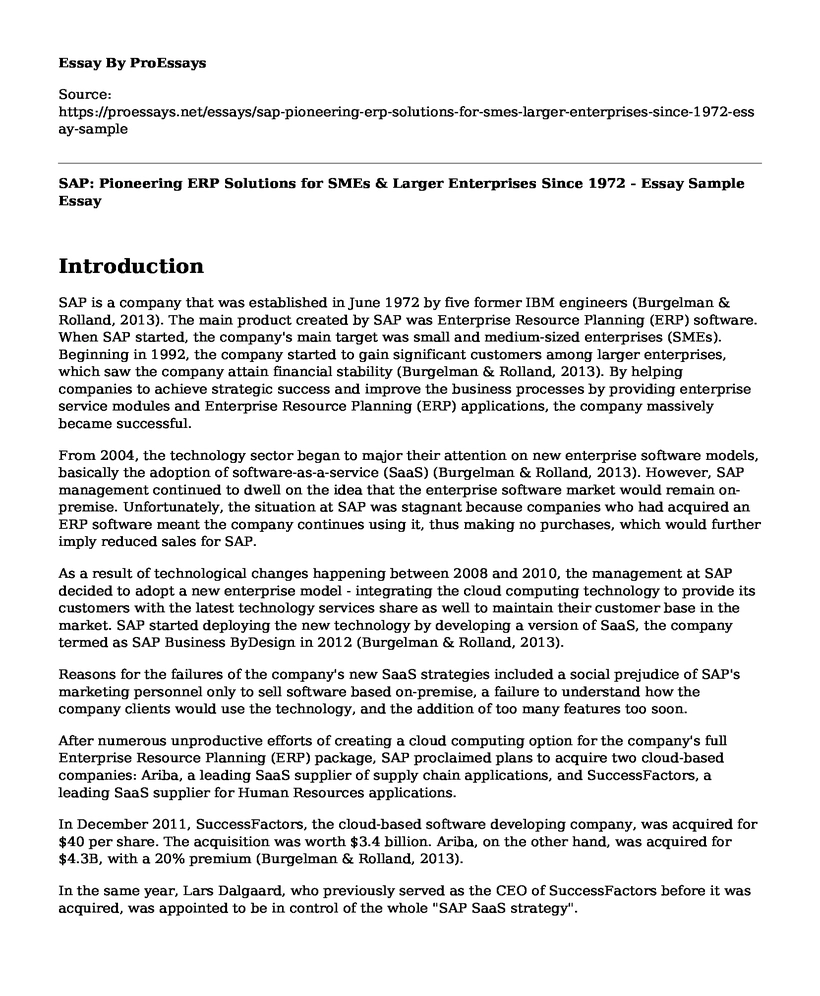Introduction
SAP is a company that was established in June 1972 by five former IBM engineers (Burgelman & Rolland, 2013). The main product created by SAP was Enterprise Resource Planning (ERP) software. When SAP started, the company's main target was small and medium-sized enterprises (SMEs). Beginning in 1992, the company started to gain significant customers among larger enterprises, which saw the company attain financial stability (Burgelman & Rolland, 2013). By helping companies to achieve strategic success and improve the business processes by providing enterprise service modules and Enterprise Resource Planning (ERP) applications, the company massively became successful.
From 2004, the technology sector began to major their attention on new enterprise software models, basically the adoption of software-as-a-service (SaaS) (Burgelman & Rolland, 2013). However, SAP management continued to dwell on the idea that the enterprise software market would remain on-premise. Unfortunately, the situation at SAP was stagnant because companies who had acquired an ERP software meant the company continues using it, thus making no purchases, which would further imply reduced sales for SAP.
As a result of technological changes happening between 2008 and 2010, the management at SAP decided to adopt a new enterprise model - integrating the cloud computing technology to provide its customers with the latest technology services share as well to maintain their customer base in the market. SAP started deploying the new technology by developing a version of SaaS, the company termed as SAP Business ByDesign in 2012 (Burgelman & Rolland, 2013).
Reasons for the failures of the company's new SaaS strategies included a social prejudice of SAP's marketing personnel only to sell software based on-premise, a failure to understand how the company clients would use the technology, and the addition of too many features too soon.
After numerous unproductive efforts of creating a cloud computing option for the company's full Enterprise Resource Planning (ERP) package, SAP proclaimed plans to acquire two cloud-based companies: Ariba, a leading SaaS supplier of supply chain applications, and SuccessFactors, a leading SaaS supplier for Human Resources applications.
In December 2011, SuccessFactors, the cloud-based software developing company, was acquired for $40 per share. The acquisition was worth $3.4 billion. Ariba, on the other hand, was acquired for $4.3B, with a 20% premium (Burgelman & Rolland, 2013).
In the same year, Lars Dalgaard, who previously served as the CEO of SuccessFactors before it was acquired, was appointed to be in control of the whole "SAP SaaS strategy".
Main Problem in the Case
The main problem in this scenario is the integration of the three companies; SAP, SuccessFactors, and Ariba, to function as one, while still retaining the customers from the three. In this case, SAP has to use Cloud computing solutions for both Ariba and SuccessFactors to rebuild its customer base. Secondly, it has to retain and grow SuccessFacor's former customer base as well as those previously served by Ariba without both of them experiencing challenges as a result of the acquisition.
Possible Solutions
In this scenario, one of the solutions SAP can adopt is to evaluate the compatibility of integrating the three companies and come up with a single improved model that can attain a better competitive advantage and serve the three customer bases efficiently.
Integrating the three companies to operate as one will result to value addition. And this increases revenue for the shareholders (Ghauri & Hassan, 2014). The integration of the three companies into one means a reduction in operating costs, where instead of functioning as three, the companies now function as one.
Another alternative solution to this problem is to operate the three companies as different units. This approach can help to minimize cultural clashes between the three companies.
References
Burgelman, R. & Rolland, J. (2013). SAP and Cloud Computing in 2012 and Beyond. [Case study]. Graduate School of Stanford Business. Retrieved from https://www.gsb.stanford.edu/faculty-research/case-studies/sap-cloud-computing-2012-beyond
Ghauri, P., & Hassan, I. (2014). Evaluating companies for mergers and acquisitions. Emerald Group Publishing.
Cite this page
SAP: Pioneering ERP Solutions for SMEs & Larger Enterprises Since 1972 - Essay Sample. (2023, May 18). Retrieved from https://proessays.net/essays/sap-pioneering-erp-solutions-for-smes-larger-enterprises-since-1972-essay-sample
If you are the original author of this essay and no longer wish to have it published on the ProEssays website, please click below to request its removal:
- Walmart Versus Competitors in Leadership Styles - Management Essay Sample
- The Business Context Analysis on Example of Apple
- Response to "Discussion the Impact of Amazon" Paper Example
- Organizational Changes on Samsung and Apple Example
- Response Essay Sample on Amazon
- Essay Sample on Apple's Impact on US Economy: $350 Billion Investment
- Essay Example on Walmart's Expansion: Benefits, Threats, and Challenges in Global Markets







